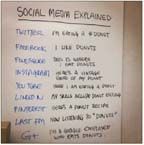Using Social Media in Oncology for Education and Patient Engagement
We presented an interactive session entitled “Using Social Media in Oncology for Education and Patient Engagement” at the American Society of Clinical Oncology (ASCO) 2012 Annual Meeting. This article summarizes the points made in those presentations.
We presented an interactive session entitled “Using Social Media in Oncology for Education and Patient Engagement” at the American Society of Clinical Oncology (ASCO) 2012 Annual Meeting. This article summarizes the points made in those presentations.
What Are “Social Media”?
FIGURE

A Simple Visual Explanation of Social Media
Social media (SM) encompass a number of online and mobile resources that provide a forum for the generation, sharing, and discussion of individuals’ ideas and content.[1] Kaplan and Haenlein describe six types of SM: collaborative projects (eg, Wikipedia), blogs and microblogs (eg, Twitter), content communities (eg, YouTube), social networking sites (eg, Facebook, Google+), virtual game worlds (eg, World of Warcraft), and virtual social worlds (eg, Second Life).[2] Although the SM “space” can be construed as highly complicated,[3] it can also be conceived of more simply (Figure).
Just as email, websites, and the Internet were once seen as novelties, SM-especially Twitter-have been seen by physicians as a digression, or something only celebrities or teenagers engage in. People are learning that there is power and utility in SM-just as they learned with email-and that Facebook and Twitter have a large impact on millions of people in our society. The most popular SM platforms include Facebook, Twitter, blogs, and YouTube. However the newer, visually based Pinterest SM site is driving more online sales than any other network, and "brands are growing faster than on Twitter," according to SocialMouths.com.[4]

Michael A. Thompson, MD, PhD

Anas Younes, MD

Robert S. Miller, MD, FACP
The SM application or network is merely a tool to access the social community-where the value and content are. The Mayo Clinic is a power-user of SM and has noted: "Our patients are doing it, so this is where we need to be".[5] That sentiment is echoed by the comment, "That’s where people are. That’s the bottom line," from Ed Bennett, who tracks the use of SM in healthcare as Director of Web Strategy for the University of Maryland Medical Center. Indeed, we are moving from “Web 1.0” to “Web 4.0”[6,7]:
Web 1.0: Content
• Passive reading of medical information.
• Example: www.cancer.gov.
Web 2.0: Communities/interaction
• Examples: www.cancer.net, disease-specific message boards.
Web 3.0: Commerce and data-driven applications
• Mobile health technologiges.
• Examples: iTunes mobile apps.
Web 4.0: Coherent web
• Information melded in a coordinated way around a single patient.
• Patient interactivity (e-patients): “empowered, engaged, equipped, enabled.”
• Patient-driven comprehensive networks.
• Examples: www.Ihadcancer.com, Avvo, HealthTap, Medicity, Emdeon
Tools and Benefits
The various SM platforms each have their pros and cons. Facebook and Twitter are widely used but may not convey detailed or subtle information adequately; however, they can be linked via tiny URLs to blogs, YouTube movies, or websites with more information.
Twitter has been described as “the trailer for the Blog movie” [paraphrased].[8] Also, tweets may predict publication citations, suggesting that “Twimpact” (twimpact.com) may be a new, earlier predictive impact factor, with highly tweeted articles 11 times more likely to be highly cited than less tweeted articles.[9] Also top-cited articles can be predicted from top-tweeted articles with 93% specificity and 75% sensitivity, and tweets can predict highly cited articles within the first three days of article publication. SM dashboard applications (apps) such as HootSuite, TweetDeck, and others can help organize and filter Twitter and other content. Apps such as Twitpic can be used to upload pictures to Twitter.
Risks and Policies
Some of the reasons oncologists don’t use Twitter include: lack of time, fear of the unknown, and not understanding it. However, if physicians are interested in trying out Twitter and other SM applications, there are some simple rules to live by-the simplest being to behave online as you would offline and to always keep in mind that any online bad behavior has a much wider audience. Farris Timimi, MD, the medical director for the Mayo Clinic Center for Social Media, has suggested the following 12-word SM policy[10]:
• Don’t lie, don’t pry.
• Don’t cheat, can’t delete.
• Don’t steal, don’t reveal.
A study from Chretien et al showed that in a sample of 5,156 physician tweets, 3% were considered unprofessional, with 0.7% revealing potentially protected health information, 0.6% using profanity, and 0.3% sexually explicit.[11] Of the users responsible for potential privacy violations, 92% used their full name and photograph in their profile. These data, and this phenomenon generally, have been commented on by many, including Dr. Bryan Vartabedian in his 33Charts.com blog post, “Physicians, Risk and Opportunity in the Digital Age.”[12]
There is likely a learning curve for physicians who want to use SM. One useful resource is “Practical Guidance: The Use of Social Media In Oncology Practice” by Dizon et al.[1] There are benefits and risks to SM. If you are interested, find a mentor, and dive in-slowly. Start by observing, learning, and then commenting.
Use of SM for Clinical Trial Recruitment
With hundreds of millions of individuals using SM outlets such as Facebook and Twitter, there is an unprecedented opportunity for physicians, healthcare professionals, caregivers, and patients to connect and share critical information in real time. One obvious benefit is the sharing of information about high-priority clinical trials for cancer. In the past, we used to rely on mass emails and flyers that were mailed out to oncologists nationwide. However, these methods were inefficient and sometimes costly. They mainly targeted oncologists, who were bombarded by so many other flyers and mass emails that notices about important clinical trials wound up in their spam folder-or the wastebasket. In contrast, using SM allows the dissemination of the same information to a larger number of individuals, which may include patients and caregivers who have a vested interest in receiving this information. One does not need to know a recipient’s street or email address to reach out and communicate. Patients can then ask simple questions about a trial to determine whether they are suitable candidates before they travel to a referring center to participate. They can choose to identify themselves as patients or they can inquire anonymously. Creating an awareness of a clinical trial should follow institutional rules but can be as simple as providing a link to the trial on Clinicaltrials.gov. Providing any additional information may require Institutional Review Board approval.
Use of SM for Patient Engagement
Engaging patients on SM outlets can provide a significant public service and give comfort to patients and their caregivers, and doctors should not be afraid to do this. SM provide unfiltered access to the oncologist, if he or she chooses to make him/herself available in this way, and can provide credible information from reliable sources. When communicating on Facebook, oncologists are advised to create a special professional account rather than use their personal account, to avoid the perception of befriending their patients. Furthermore, oncologists should provide only basic general educational information and not offer specific recommendations to patients.
SM For Professional Education
Oncologists might use healthcare-related SM (HCSM) for one of three primary purposes:
1. To treat: to engage directly with patients about care.
2. To teach: to provide timely and credible education to patients and/or the public.
3. To learn: to share medical information/knowledge with other physicians and healthcare professionals.
With regard to the third purpose, there is steady growth in opportunities for oncologists to use HCSM applications and tools for professional education, continuous professional development, and interaction with other healthcare professionals. Examples include blogs (WordPress, Google Blogger), microblogs (Twitter, Tumblr), social networks (Facebook, Google+, LinkedIn), collaborative tools (wikis), multimedia content sharing (YouTube, Flickr, podcasts, Instagram, Pinterest, Slideshare), and social bookmarking (Diigo, Delicious, CiteULike). Most of these applications were initially developed for recreational and entertainment purposes and/or for their commercial value, but use for professional purposes is increasing.
The degree to which SM have become part of the daily workflow of most physicians is not known with certainty, since many surveys of physician use have not consistently separated personal from professional use. Ohno-Machado and von Muhlen performed a systematic review of SM adoption studies contained in the PubMed database, focusing specifically on clinician use. Their analysis was limited by variable definitions for HCSM. Use of Facebook, as expected, was high for the younger demographic but lower for older physicians; the use of Wikipedia as a reference source was prevalent. Overall, the adoption of SM by clinicians increased from 2007 to 2011.[13] Cooper et al analyzed data from the 2009 DocStyles survey sponsored by ePocrates (San Mateo, Calif) of 1,750 physicians in four primary care specialties and dermatology. The survey inquired about use in the preceding 6 months of a variety of “Internet-based communication technologies,” including social networking sites (participation), blogs (creation), and podcasts (downloading); they found affirmative responses in 59.1%, 12.9%, and 41.4% of respondents, respectively.[14] Age 35 to 44 years, male sex, and practicing in a teaching hospital were modestly correlated with increased use, but again, no distinction was made between personal and professional use. McGowan et al[15] reported on an email survey of 299 primary care physicians and 186 oncologists, specifically querying use of HCSM for “sharing medical information” with other physicians; the authors found that adoption of “Web 2.0” tools such as Twitter, Facebook, blogs, and podcasts for this purpose was relatively weak. However, over half of those surveyed participated in restricted online professional communities such as Doximity or Sermo. Oncologists tended to be more skeptical of SM than primary care physicians: eg, 35% were “adamant non-adopters” of Twitter. A predictive analysis of the same dataset showed that perceived ease of use and usefulness of the technology were the factors that best explained physician adoption of HCSM for sharing medical information with other physicians. Age, gender, specialty, and patient volumes did not seem to influence use.[16]
Physicians who wish to explore the professional use of HCSM might consider starting with Twitter, given its low barrier to entry, versatility across platforms (including virtually all mobile devices), and minimal requirements for content production (140-character tweets vs 300- to 500-word blog posts). Twitter is asymmetric, since “following” another user does not require reciprocation, and this may be reassuring to new users who are uncomfortable with the “familiarity” of SM connections. The three authors of this manuscript, who are all busy oncology clinicians, use Twitter on a daily basis in the outbound direction as part of our usual online workflow, to share a broad spectrum of topics of interest to our followers; the latter include subspecialty clinical oncology, general medicine, health IT, health services research, sports, politics, and entertainment. Tweets can be enriched by the inclusion of links to external sources, and embedded URL shortening tools can facilitate this. However, we have found that the greatest value of Twitter is in the inbound direction, in interacting with a community of followers that constitute a personal learning network for sharing information and crowdsourcing questions. While there can be a gradual start-up phase, this often lasts only a few months. The growth of a new user’s Twitter following is directly correlated with his or her level of engagement with the Twitter ecosystem; such engagement includes contributing meaningful content through link-sharing and commentary, rebroadcasting others’ tweets (“retweeting”), and engaging in online dialogue.
Twitter can be particularly useful at medical conferences, as a means of interacting and sharing conference information with other attendees, whether on-site or not. This is usually done by means of a designated meeting hashtag (eg, #ASCO12), a piece of metadata that can be added to a tweet for tracking purposes. Twitter usage grew significantly at the ASCO Annual Meetings from 2009 to 2012, and a content analysis of the 2010 and 2011 Annual Meeting Twitter streams showed significant use by physicians to report breaking news or trial outcomes presented at the meeting. Additionally, Twitter was used for surprisingly robust clinical management discussions, often about new treatments being presented, and conversation threads could be distinguished in the analysis.[17] Twitter use was prominent at many scientific conferences in 2011 and 2012, and it is rare now to find a meeting without an official hashtag. A detailed analysis of tweets at the American Society of Nephrology Kidney Week 2011 meeting showed that 29% had informative content, educating the reader about some aspect of kidney disease; the most effective tool for dissemination of knowledge was an internal citation (retweet).[18]
In addition to concerns about violating patient privacy, the greatest reservation of most physicians regarding SM is the perceived time commitment. However, in our experience, this can be effectively managed by designating distraction-free time zones in the workday and by assiduously avoiding any use of HCSM that interferes with patient care. Most experienced physician SM participants find that the time devoted to Twitter and Facebook for professional use replaces the time previously spent on less focused web-surfing to news and journal sites. Knowledge gained in a SM context will never replace direct scholarly activity such as searching PubMed or other databases, but interaction with an engaged and diverse community of likeminded SM users can point to new information and yield unexpected insights and connections that might never have been discovered otherwise.
Conclusions
SM in its myriad forms is a popular vehicle for sharing information. SM platforms are tools for accessing the social community; they offer value and content for patient engagement, clinical trial recruitment, and professional education. For medicine in general and oncology specifically, we realize that “our patients are doing it, so this is where we need to be.” Find a mentor and explore.
References:
REFERENCES
1. Dizon DS, Graham D, Thompson MA, et al. Practical guidance: the use of social media in oncology practice. J Oncol Pract. 17 July 2012. [epub ahead of print]
2. Social media. Wikipedia 2012 [cited Social media]. Available from: http://en.wikipedia.org/wiki/Social_media. Accessed August 10, 2012.
3. Minato C. This INSANE graphic shows how ludicrously complicated social media marketing is now. Business Insider 2012 [cited 2012]. Available from: http://www.businessinsider.com/social-media-marketing-landscape-complicated-2012-5. Accessed August 10, 2012.
4. Thompson MA. Pinterest for medicine & oncology: an opportunity. 2012. Available from: http://connection.asco.org/Commentary/Article/ID/3240/Pinterest-for-Medicine-Oncology-An-Opportunity.aspx. Accessed August 10, 2012.
5. Why Mayo Clinic is a power user of social media: "Our patients are doing it, so this is where we need to be." CasesBlog - Medical and health blog. Ves Dimov, MD. 2012 [cited 2012]; Available from: http://casesblog.blogspot.com/2012/01/why-mayo-clinic-is-power-user-of-social.html. Accessed August 10, 2012.
6. Nash DB. Health 3.0. Pharm Ther. 2008;33:69,75.
7. Millard M. Medicity, Emdeon join on 'Health 4.0.' Healthcare IT News. Apr 2010;1. Available from: http://www.healthcareitnews.com/news/medicity-emdeon-join-health-40. Accessed August 30, 2012.
8. Schaefer MW. The tao of Twitter. New York: McGraw-Hill; 2011.
9. Eysenbach G. Can tweets predict citations? Metrics of social impact based on Twitter and correlation with traditional metrics of scientific impact. J Med Internet Res. 2011;13:e123.
10. Timimi F. A 12-word social media policy. 2012 [cited 2012]. Available from: http://socialmedia.mayoclinic.org/2012/04/05/a-twelve-word-social-media-policy/. Accessed August 10, 2012.
11. Chretien KC, Azar J, Kind T. Physicians on Twitter. JAMA. 2011;305:566-8.
12. Vartabedian B. Physicians, risk and opportunity in the digital age. 33 charts2011 [cited 2012]; Available from: http://33charts.com/2011/12/physicians-risk-opportunity-social-media.html. Accessed August 10, 2012.
13. von Muhlen M, Ohno-Machado L. Reviewing social media use by clinicians. J Am Med Inform Assoc. 3 July 2012. [epub ahead of print]
14. Cooper CP, Gelb CA, Rim SH, et al. Physicians who use social media and other Internet-based communication technologies. J Am Med Inform Assoc. 25 May 2012. [epub ahead of print]
15. McGowan BS, Vartabedian B, Miller R, Wasko M. The “meaningful use” of social media by physicians for learning. Presented at Medicine 2.0'11, 4th World Congress on Social Media and Web 2.0 in Health, Medicine, and Biomedical Research; Stanford, Calif. 2011.
16. McGowan BS, Wasko M, Vartabedian B, et al. Factors that influence the adoption and use of social media by physicians to share medical information. J Med Internet Res. In press.
17. Chaudhry A, Glodé LM, Gillman M, Miller RS. Trends in Twitter use by physicians at the American Society of Clinical Oncology Annual Meeting, 2010 and 2011. J Oncol Pract. 2012;8:173-178.
18. Desai T, Shariff A, Shariff A, et al. Tweeting the meeting: an in-depth analysis of Twitter activity at Kidney Week 2011. PLoS One. 2012;7:e40253.
19. Social media explained a la @ThreeShipsMedia. 2012 [cited 2012]; Available from: http://instagram.com/p/nm695/. Accessed August 10, 2012.
Newsletter
Stay up to date on recent advances in the multidisciplinary approach to cancer.
Oncology Peer Review On-The-Go: Cancer Care Management During the COVID-19 Pandemic
October 28th 2020The newest episode of Oncology Peer Review On-The-Go speaks with 2 authors of an article from the October Issue of the journal ONCOLOGY focusing on effective cancer care management during the coronavirus pandemic.
Oncology Peer Review On-The-Go: Cancer Care Management During the COVID-19 Pandemic
October 28th 2020The newest episode of Oncology Peer Review On-The-Go speaks with 2 authors of an article from the October Issue of the journal ONCOLOGY focusing on effective cancer care management during the coronavirus pandemic.
2 Commerce Drive
Cranbury, NJ 08512
All rights reserved.